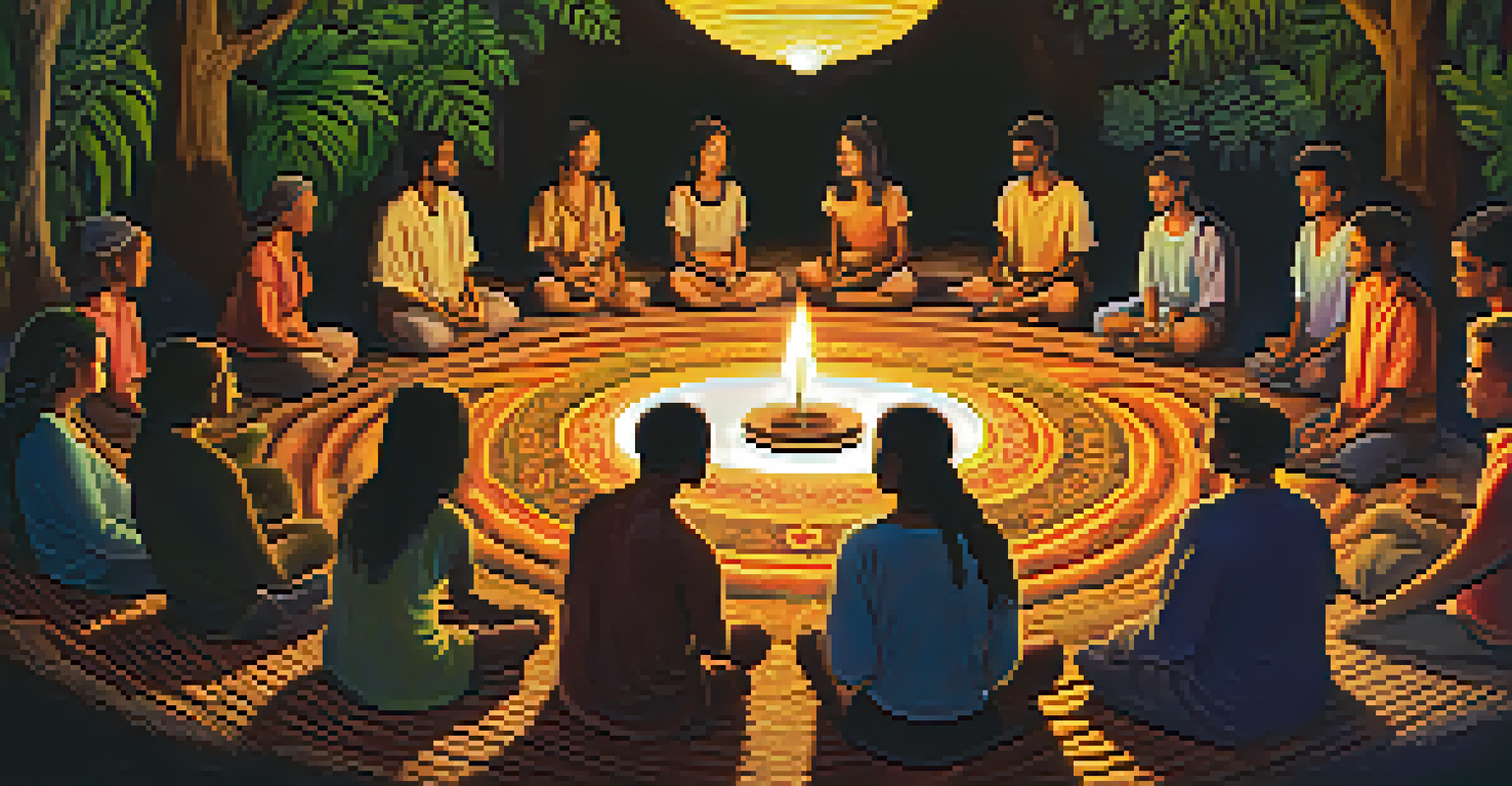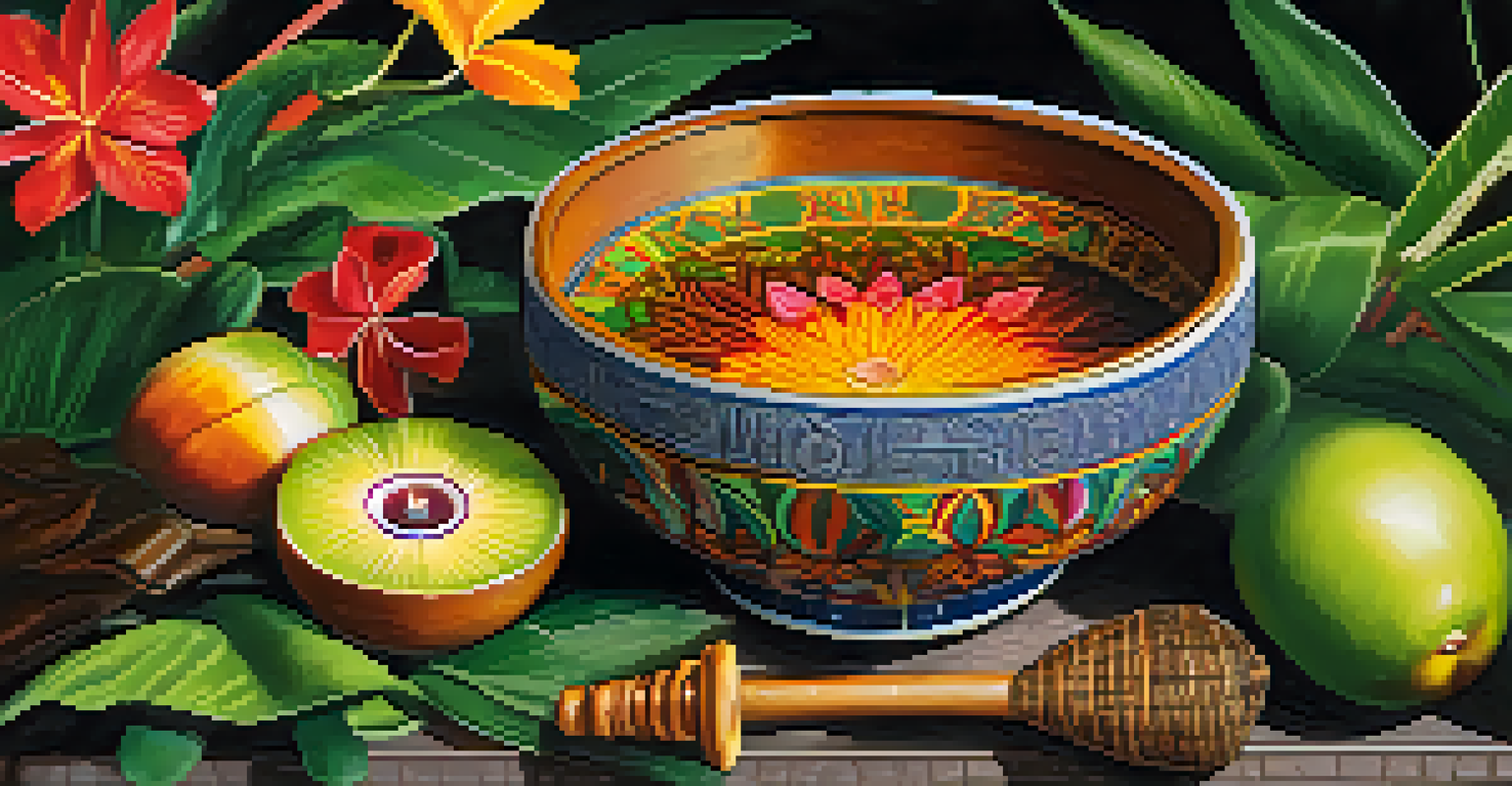Unlocking Genuine Self-Expression Through Ayahuasca Rituals

Understanding Ayahuasca and Its Cultural Significance
Ayahuasca is a powerful plant medicine originating from the Amazon, traditionally used by indigenous cultures for spiritual healing and connection. This brew, made from the Banisteriopsis caapi vine and other plants, offers a profound journey into the self. Many participants seek it out as a means to explore their inner landscapes and connect with deeper truths about themselves.
The journey of a thousand miles begins with one step.
The cultural significance of Ayahuasca rituals cannot be understated; they are often conducted by experienced shamans who guide participants through the experience. These ceremonies are steeped in tradition, emphasizing the importance of community and shared vulnerability. It’s within these sacred spaces that individuals can encounter both the light and dark aspects of their psyche.
As the popularity of Ayahuasca spreads beyond the Amazon, it's crucial to approach these rituals with respect and understanding of their origins. Engaging in Ayahuasca without recognizing its cultural roots can lead to misunderstandings and disrespect. Therefore, education about its significance is essential before embarking on this transformative journey.
The Journey Within: What to Expect
When participating in an Ayahuasca ceremony, individuals can expect a range of emotional and psychological experiences. The journey may involve vivid visions, intense emotions, and deep introspection, which can feel overwhelming yet liberating. Many participants describe experiencing a sense of clarity and insight that helps them confront personal challenges they may have been avoiding.

It's important to prepare mentally and physically for the experience, as the effects of Ayahuasca can vary widely from person to person. Some may experience purging, which can be seen as a form of release, helping to clear emotional blockages. This process often leads to significant moments of self-discovery, allowing participants to confront fears or traumas they’ve been holding onto.
Cultural Roots of Ayahuasca
Ayahuasca ceremonies are deeply rooted in indigenous traditions, emphasizing respect and understanding of their cultural significance.
Navigating this internal landscape can feel daunting, but many find that the supportive environment of the ceremony helps ease their journey. With a skilled shaman guiding the way, participants are encouraged to surrender to the experience, trusting in the process. This act of surrender is often where the magic happens, unlocking layers of genuine self-expression.
Healing Through Vulnerability and Connection
One of the most profound aspects of Ayahuasca rituals is the opportunity for vulnerability. During these ceremonies, individuals are often encouraged to share their experiences and emotions with others, fostering a sense of connection. This shared vulnerability creates a safe space for healing, as participants realize they are not alone in their struggles.
What lies behind us and what lies before us are tiny matters compared to what lies within us.
The communal aspect of Ayahuasca rituals enhances the experience, allowing participants to witness one another's journeys. This collective energy can amplify personal revelations, as individuals support each other in their moments of insight. As they share their stories, a deeper understanding of the human experience emerges, breaking down barriers that often inhibit genuine self-expression.
Moreover, this connection often leads to lasting friendships, as participants bond over their shared experiences. Many leave the ceremony feeling a renewed sense of belonging and a commitment to express their authentic selves, both during and after the ritual. This ongoing support network can help maintain the lessons learned during the ceremony, fostering continued growth and healing.
Facing Fears and Overcoming Limiting Beliefs
Ayahuasca has a unique ability to bring fears and limiting beliefs to the surface, prompting individuals to confront what holds them back. Many participants report facing deep-seated anxieties or beliefs that have shaped their lives in negative ways. This confrontation can be challenging, but it often leads to profound breakthroughs and a more authentic way of living.
Through the lens of Ayahuasca, participants may begin to see their fears not as insurmountable obstacles but as opportunities for growth. By acknowledging and processing these fears, individuals can transform their relationship with them, paving the way for personal empowerment. This shift often ignites a newfound sense of freedom, allowing for genuine self-expression.
Emotional Healing Through Vulnerability
The communal aspect of Ayahuasca rituals fosters a safe space for participants to share experiences, enhancing healing through shared vulnerability.
As participants learn to navigate their fears, they often discover core beliefs that no longer serve them. The journey doesn’t end with the ceremony; it’s a continuous process of integrating these insights into everyday life. This integration allows for more authentic interactions and a deeper connection to oneself and others.
Integrating Insights into Everyday Life
Emerging from an Ayahuasca ceremony can feel like stepping into a new reality, filled with fresh perspectives and insights. However, the challenge lies in integrating these revelations into daily life. This process is crucial for turning the experience into lasting change, allowing participants to express their true selves beyond the ceremony.
Many find that journaling, meditation, or creative outlets serve as effective tools for integration. These practices help individuals reflect on their experiences and emotions, reinforcing the lessons learned during the ritual. By actively engaging with these insights, participants can cultivate a more authentic way of living.
Additionally, ongoing support from the community formed during the ceremony can play a pivotal role in this integration. Sharing experiences with others who have undergone similar transformations fosters a sense of accountability. This collective encouragement helps individuals stay committed to their journey of genuine self-expression.
The Role of Intention in the Ayahuasca Experience
Setting an intention before participating in an Ayahuasca ceremony is essential, as it can significantly influence the experience. Intentions act as a guiding light, helping participants navigate the often tumultuous waters of their inner psyche. By clarifying what they hope to achieve, individuals can focus their energy and attention on specific areas of self-exploration.
Participants may set intentions around themes such as healing, forgiveness, or self-love. This focus can help channel the experience toward addressing these specific areas, making the journey feel more purposeful. A clear intention can transform the experience from a passive observation to an active engagement with one’s inner world.
Importance of Integration Practices
Integrating insights gained from an Ayahuasca ceremony into daily life is essential for lasting personal growth and authentic self-expression.
Moreover, discussing intentions with the shaman and fellow participants can deepen the experience. This dialogue fosters a sense of community and shared purpose, enhancing the overall impact of the ceremony. As individuals align their intentions with the collective energy, they often find themselves unlocking deeper layers of self-expression and insight.
Continuing the Journey: Resources and Support
The journey of self-expression and healing doesn’t end with the Ayahuasca ceremony; it’s just the beginning. To continue this transformative path, participants can explore various resources, such as books, online communities, and workshops focused on integration. These tools can provide ongoing support as individuals navigate their new insights and challenges.
Engaging with therapists or guides who specialize in integration can also be incredibly beneficial. These professionals can help participants process their experiences and develop strategies for incorporating their insights into daily life. Having a supportive figure during this phase can make a significant difference in maintaining the momentum gained during the ceremony.

Lastly, connecting with others who have shared similar experiences can create a sense of belonging and understanding. Support groups or online forums can be invaluable spaces for sharing challenges and celebrating progress. This continued engagement fosters a deeper connection to oneself and the community, ensuring that the journey toward genuine self-expression remains vibrant and alive.